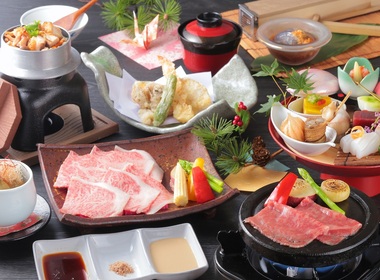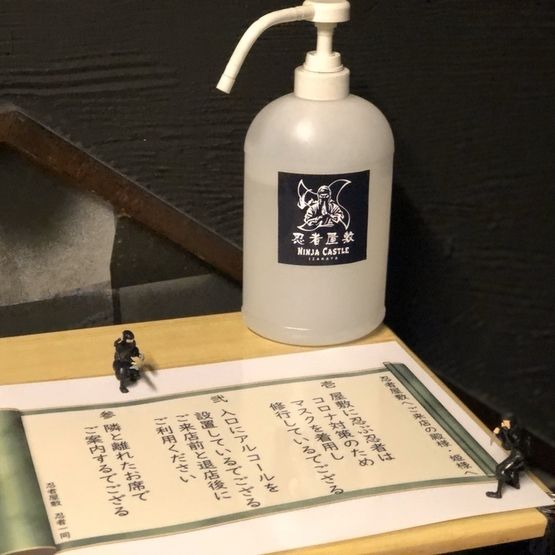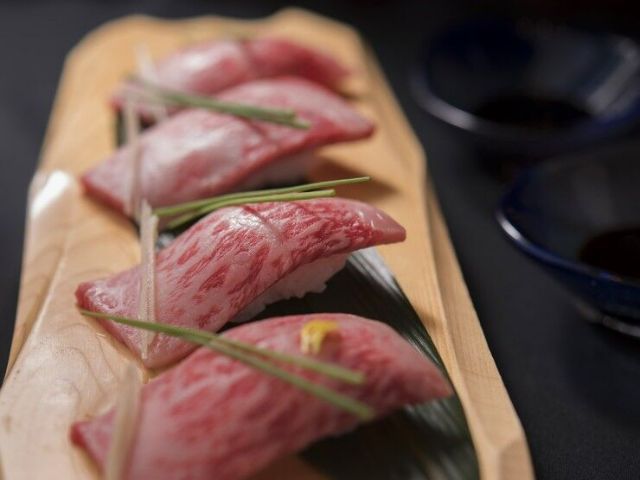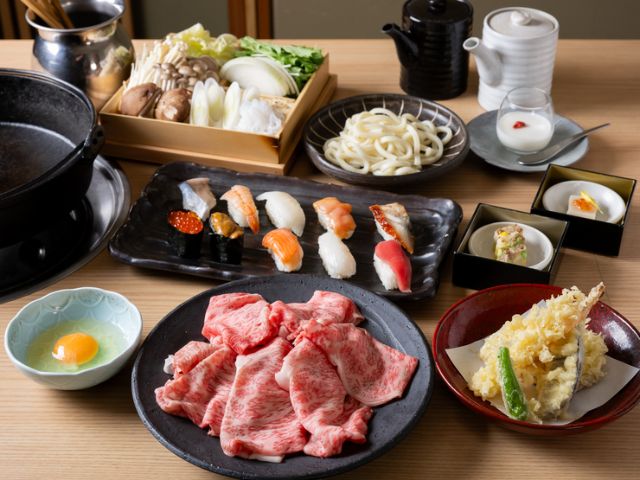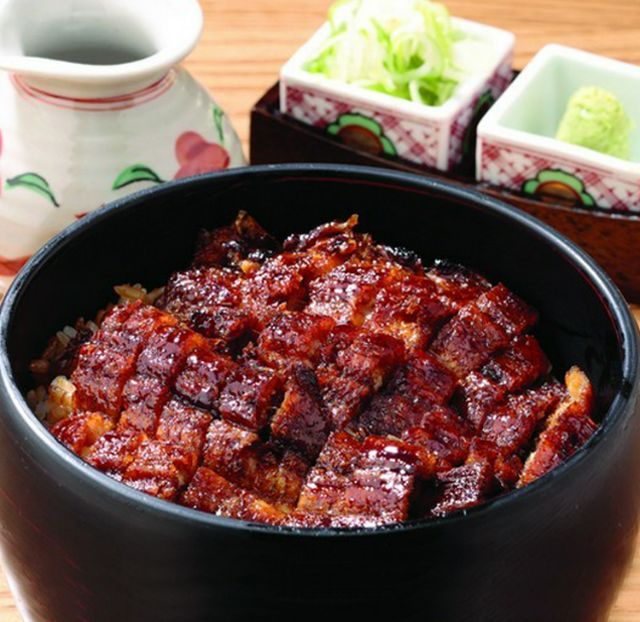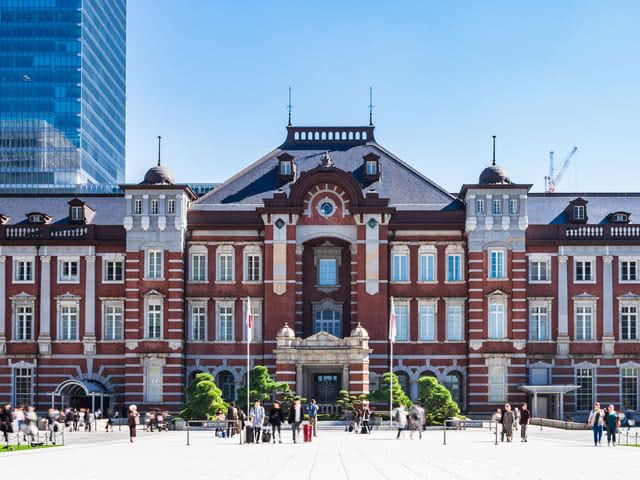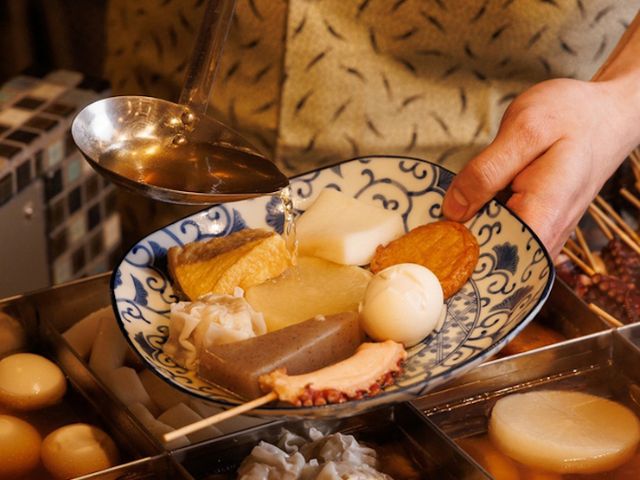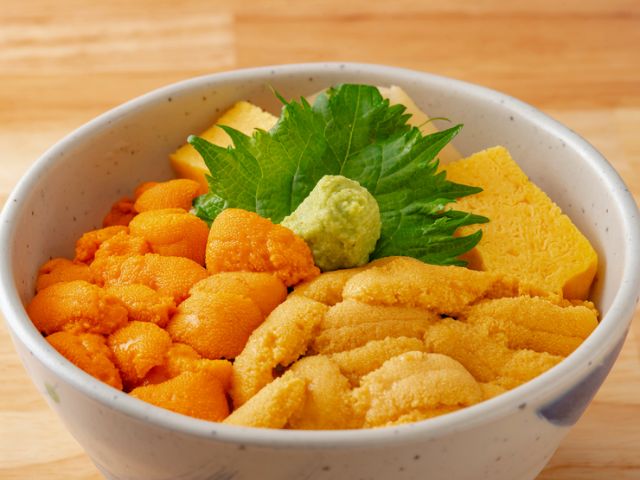Get to Know the Easy-to-Eat Kushiage and Kushikatsu
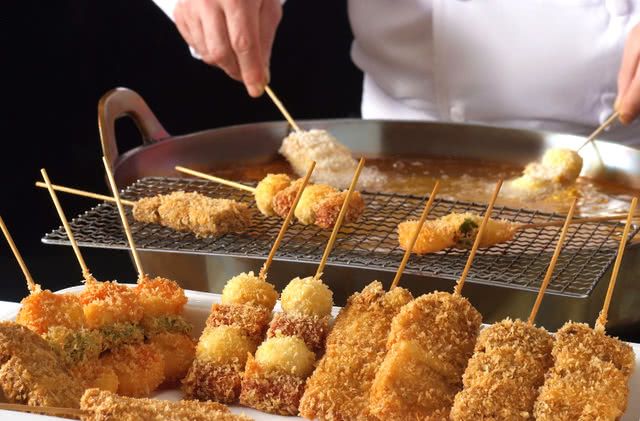
What Are Kushiage and Kushikatsu?
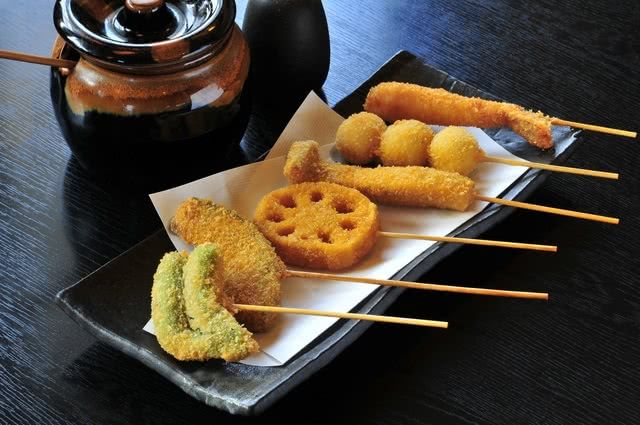
So, how are kushiage and kushikatsu different from each other? There are four differences: ingredients, sauce, coarseness of the breadcrumbs, and price range in restaurants. Let's take a look at these differences.
・Ingredients
Generally, kushiage is served with just one kind of ingredient on every skewer. All kinds of ingredients, such as meat, fish, and vegetables, are used in making kushiage, so naturally, there are many types of kushiage available. On the other hand, the main ingredient of kushikatsu is meat, usually pork cut into 3–4 cm cubes that are then skewered alternately with onions or scallions. Note, though, that many kushikatsu restaurants also have vegetables, seafood, quail eggs, and other variations on their menus.
・Sauce
Kushiage and kushikatsu restaurants have their own distinct type of sauce and way of using it. At kushiage restaurants, the kushiage is not only eaten with kushiage sauce but also with salt, lemon juice, and various other condiments. The stick of kushiage is dipped in the sauce and then sprinkled with the condiments that are served in small dishes. At kushikatsu restaurants, the sauce is put in a container that is placed on the table, and then the ingredients are dipped in it.

While this is not really a major difference, fine breadcrumbs are used more often when cooking kushiage. In the case of kushikatsu, it seems that many restaurants use coarse breadcrumbs.
・Price range in restaurants
The most glaring difference between kushiage and kushikatsu is the price. Some restaurants offer all-you-can-eat kushiage, but there are many more upscale restaurants serving this dish. Kushikatsu, on the other hand, is a food that became popular among laborers in Osaka, so their prices are affordable and the restaurants serving them are more aimed towards the working class.
Be Careful When Dipping Kushikatsu in the Sauce!
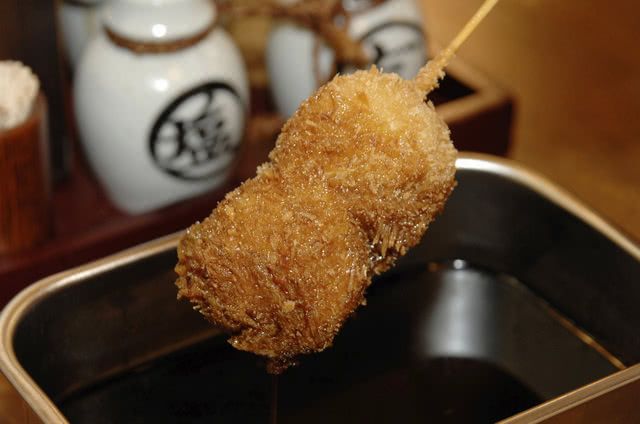
The cardinal rule in kushikatsu restaurants is "no double-dipping." There is a container filled with sauce on the table, and you dip your kushikatsu in the sauce before you eat it. For hygienic reasons, a stick of kushikatsu that has been in your mouth must not be dipped in the same sauce container again. But if the restaurant gives you your own sauce and salt in individual dishes, then you can double-dip all you want.

3 Recommended Kushiage and Kushikatsu Restaurants
Pontocho Kushiyoshi (Gion-shijo)

Pontocho Kushiyoshi is the place to go if you want to treat yourself to unique kushiage that are not only beautiful to the eye but also use premium ingredients.
You have to try the [Angel Shrimp Kadaifu Roll] (500 JPY). Caught near New Caledonia, the island said to be closest to heaven, angel shrimp are a beautifully plump and sweet kind of shrimp. In this dish, the shrimp is wrapped in kadaif, which are extremely thin noodles that originated in the Middle East. The roll is light and crispy, yet you can truly taste all the qualities of the shrimp in it.
There are many other kushiage variants that use premium ingredients at this restaurant, including the [Eggplant with Foie Gras] (580 JPY) that has a rich aroma thanks to the truffle sauce, and the [Scallops with Caviar] (500 JPY) with the refreshing flavor of shiso leaf.
Here, you will find a wide array of kushiage that make the most of the ingredients and are served in creative ways.
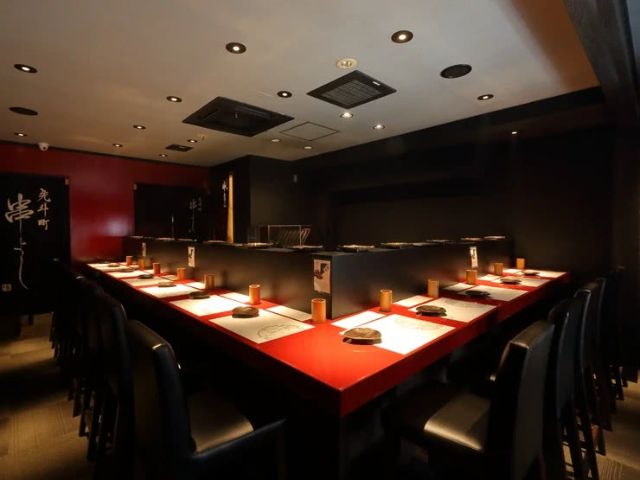
The second floor is a brightly lit tatami room decorated with gorgeous and colorful flowers, creating a sophisticated ambience.
Pontocho Kushiyoshi
Closed: None
Average price: [Dinner] 7,000 JPY / [Lunch] 7,000 JPY
Access: 5-minute walk from Exit 4 of Gion-shijo Station on the Keihan Main Line. Right next to Pontocho Park on Pontocho Street. The red curtain is a mark of the restaurant.
Address: 191-6, Shimokoriki-cho, Nakagyo-ku, Kyoto-shi, Kyoto Map
More Details Reservation
Kushikatsu Sakaba Hirokatsu Shibuya Dogenzaka Branch (Shibuya)
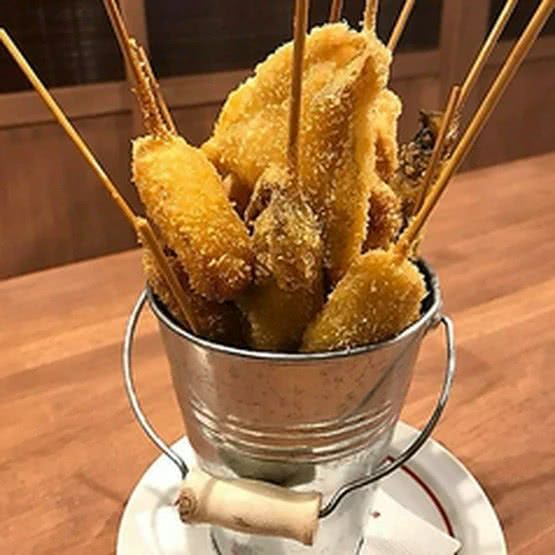
Try the [Kushikatsu Bucket] (1,648 JPY) with 15 different kinds of kushikatsu. You'd surely be amazed at how it looks! You can also order kushikatsu a la carte for as little as 109 JPY.

Kushikatsu Sakaba Hirokatsu Shibuya Dogenzaka Branch is relatively close to Shibuya Station, so it's quite a convenient stopover after a day of sightseeing.
Kushikatsu Sakaba Hirokatsu Shibuya Dogenzaka Branch
Closed: Irregular
Average price: [Dinner] 3,000 JPY
Access: 3-minute walk from Shibuya Station
Address: B1F, 1-5-4, Dogenzaka, Shibuya-ku, Tokyo Map
More Details Reservation
Kushitei Kyobashi Ginza-itchome (Kyobashi)
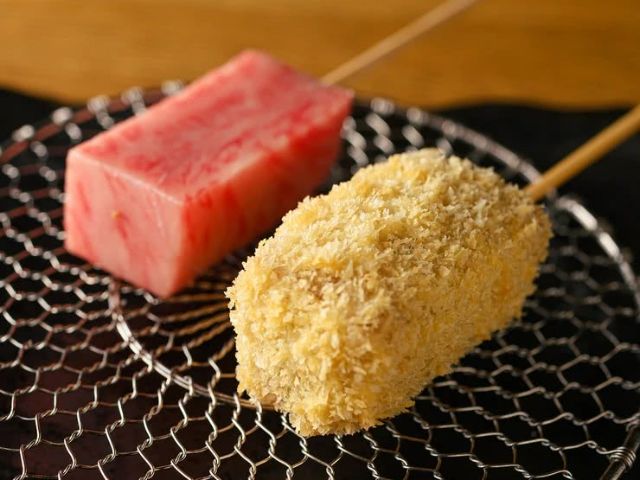

The restaurant offers a variety of seating options, from counter seats that will let you feel like you are in the middle of where everything happens, to private rooms where you can sit back and relax while you eat.
Kushitei Kyobashi Ginza-itchome
Closed: Irregular
Average price: [Dinner] 6,500 JPY / [Lunch] 1,500 JPY
Access: 132m from Kyobashi Station
Address: B1F, Tokyo Square Garden, 3-1-1, Kyobashi, Chuo-ku, Tokyo Map
More Details Reservation
Disclaimer: All information is accurate at time of publication.
Thank you for reading our article.
Our goal is to take your culinary journey to the next level by helping you find the best restaurant. With SAVOR JAPAN, you can search and make reservations for
the Japanese Cuisine restaurants found in and around Tokyo and Kyoto that fill your needs.
Discover more Japanese Cuisine restaurants by area
- Tokyo Area
- Near Tokyo
- Kyoto and Osaka Area
- Hokkaido Area
- Northern Honshu (Tohoku)
- Central Honshu (Chubu)
- Western Honshu (Chugoku)
- Shikoku
- Kyushu
- Okinawa and Ryukyu Islands
Discover more restaurants to eat Japanese Cuisine by area
Keywords
Related Articles
New Articles
Categories
Cuisine
- Bars (23)
-
Japanese Cuisine (677)
- Kaiseki (46)
- Nabe (19)
- Okonomiyaki (24)
- Shabu Shabu (37)
- Soba (18)
- Sushi (137)
- Tempura (19)
- Teppanyaki (46)
- Shojin Ryori (3)
- Tonkatsu (11)
- Kushiyaki (10)
- Yakitori (44)
- Sukiyaki (35)
- Japanese Cuisine (342)
- Oyster (2)
- Sashimi/ Seafood (20)
- Unagi (eel) (31)
- Motsu Nabe (offal hotpot) (6)
- Mizutaki (chicken hot pot) (3)
- Oden (8)
- Kaisendon (seafood bowl) (9)
- Udon (2)
- Taverns(Izakaya) Cuisine (124)
- Western Cuisine (42)
- Italian/French Cuisine (95)
- Yakiniku/Steak (225)
- Chinese Cuisine (26)
- Ramen (Noodles) Cuisine (25)
- Cafe/Sweets (60)
- Other Asian Cuisine (5)
- Global/International Cuisine (7)
- Alcohol (45)
- Other (11)
Area
- Shikoku (10)
- Kyoto and Osaka (344)
-
Tokyo (458)
- Tokyo (284)
- Ginza (43)
- Roppongi (22)
- Shibuya (26)
- Shinjuku (46)
- Asakusa (20)
- Ebisu (12)
- Tsukiji (10)
- Tokyo Landmarks (4)
- Ueno (23)
- Akihabara (9)
- Ikebukuro (12)
- Jiyugaoka, Denenchofu, Nakameguro (9)
- Shimokitazawa (4)
- Kichijoji (3)
- Tachikawa (1)
- Omotesando, Harajuku, Aoyama (18)
- Akabane (1)
- Kagurazaka (4)
- Akasaka (10)
- Odaiba (1)
- Tsukishima, Harumi, Toyosu (3)
- Near Tokyo (100)
- Okinawa and Ryukyu Islands (58)
- Hokkaido (124)
- Northern Honshu (Tohoku) (31)
- Central Honshu (Chubu) (144)
- Western Honshu (Chugoku) (32)
- Kyushu (92)
Archives
- December 2025(8)
- November 2025(4)
- October 2025(3)
- September 2025(6)
- August 2025(11)
- July 2025(19)
- June 2025(18)
- May 2025(34)
- April 2025(43)
- March 2025(30)
- February 2025(36)
- January 2025(26)
- December 2024(69)
- November 2024(31)
- October 2024(15)
- September 2024(39)
- August 2024(65)
- July 2024(31)
- June 2024(54)
- May 2024(61)
- April 2024(28)
- March 2024(31)
- February 2024(42)
- January 2024(32)
- December 2023(20)
- November 2023(5)
- October 2023(11)
- September 2023(7)
- August 2023(18)
- July 2023(8)
- June 2023(8)
- May 2023(18)
- April 2023(15)
- March 2023(1)
- January 2023(1)
- April 2022(2)
- March 2022(2)
- February 2022(1)
- January 2022(1)
- July 2021(1)
- March 2021(1)
- February 2021(1)
- December 2020(1)
- October 2020(1)
- September 2020(2)
- August 2020(10)
- July 2020(6)
- June 2020(9)
- May 2020(11)
- April 2020(8)
- March 2020(8)
- February 2020(13)
- January 2020(9)
- December 2019(24)
- November 2019(8)
- August 2019(14)
- July 2019(15)
- June 2019(18)
- May 2019(17)
- April 2019(16)
- March 2019(22)
- February 2019(22)
- January 2019(26)
- December 2018(34)
- November 2018(40)
- October 2018(32)
- September 2018(11)
- August 2018(8)
- July 2018(6)
- June 2018(9)
- May 2018(10)
- April 2018(21)
- March 2018(74)
- February 2018(39)
- January 2018(26)
- December 2017(59)
Keywords
- Omakase
- Accessible
- Affordable
- All-You-Can-Eat
- Amazing Scenery
- anime
- Art
- Autumn
- Awards
- Beer Gardens
- Breakfast
- Chef Recommendations
- Cherry Blossoms
- Chinese
- Close To Station
- Condiments
- Counter
- Coupon
- Crab
- Culture
- Dassai
- Dates
- delivery
- Early Summer
- Editor's Recommendation
- English Available
- Event
- Expo
- Fall Leaves
- Family-Friendly
- Famous Restaurant
- Famous Tourist Spot
- Fast Food
- festival
- fireworks
- Flower Farm
- Free Wi-Fi
- French
- Great Location
- Guide
- Hibachi
- hotpot
- How To
- hydrangea
- Hygiene
- Illumination
- Italian
- Izakaya
- Japanese
- Japanese alcohol
- jingisukan
- Kaiseki
- Kappo
- Kushiage
- Kushikatsu
- Kyoto
- Late-Night
- Lunch
- Manners
- matsusakagyu
- Michelin
- mizutaki
- Model Course
- monjayaki
- motsunabe
- Mt.Fuji
- Multilingual Menus
- Nabe
- Narita Airport
- New Year
- Ninja
- Noodle
- Oden
- Okonomiyaki
- omotenashi
- Onsen
- Osaka
- Osaka Station
- Photogenic Site
- pizza
- PR
- Private Room
- Ramen
- ranking
- Recipe
- Regional Cuisine
- Resort
- Rice Bowl Dish (Donburi)
- sacred places
- Sake
- Sakura
- Sashimi
- sea urchin
- Setouchi Area
- Shabu Shabu
- sightseeing
- Signature Dish
- Soba
- Solo Diners Welcomed
- Spicy Food
- Spring
- Steak
- Summer
- Sunflower
- Sushi
- takeout
- Teppanyaki
- Terrace Seating
- Tokyo
- Tokyo Experiences
- Tokyo Skytree
- Tokyo Tower
- unagi
- UNESCO
- Vegan
- Vegetarian
- Wagyu
- What Popular Gourmet Sites Recommend
- Whisky
- Wine Bar
- Winter
- Wisteria
- Workshop
- World Heritage Site
- World Writers
- Yakiniku
- Yoshoku
- Yuba
- Zen
Discover Restaurants By Area
-

Tokyo Area
Japan's largest city, Tokyo, is the center of culinary culture in Japan. Countless Tokyo restaurants serve every kind of food imaginable and the Toyosu fish market keeps restaurants stocked with the nation's finest fish.
-

Near Tokyo
Coastal areas, mountains and valleys surrounding Tokyo are bursting with tourist destinations, such as hot springs and ski slopes, where many unique foods are only available locally.
-

Kyoto and Osaka Area
The cities of Kyoto and Osaka, together with their surrounding areas, have greatly influenced Japan's culinary culture since the 7th Century. The region is renowned for its entertainment, Kobe beef, and wide-ranging traditional dishes.
-

Hokkaido Area
The island of Hokkaido is home to wide-ranging produce of the finest quality, such as rice, meat, vegetables, fish and fruit. Popular dishes from Hokkaido include robatayaki (food slowly roasted on skewers) and Sapporo miso ramen.
-

Northern Honshu (Tohoku)
The northern end of Japan's main island, Honshu, is renowned for its seasonal fruit and vegetables, nation-leading harvest of fish (especially tuna from Ohma), and delicious beef from Yonezawa, Sendai and Yamagata.
-

Central Honshu (Chubu)
Chubu is in the center of Japan's main island, Honshu, and its culinary culture reflects its position between Japan's western and eastern halves. Delicious Hida beef, world-famous Mount Fuji and many acclaimed sake breweries are in Chubu.
-

Western Honshu (Chugoku)
Chugoku, on the southwest of Japan's main island, is rich with diverse produce. Many of its products are praised as Japan's best, including Matsuba crabs from Tottori and oysters from Hiroshima. Its pears and muscats are also top grade.
-

Shikoku
The mild climate of Shikoku is ideal for growing citrus fruit such as sudachi. Shikoku is also famous for Sanuki udon noodles, huge yields of tiger prawn from Ehime Prefecture and the best torafugu (tiger globefish) in the country.
-

Kyushu
Western culture was first introduced to Japan through Kyushu, Japan's third largest island, where the influence of Portuguese and other western cuisine influenced the creation of a colorful culinary tradition.
-

Okinawa and Ryukyu Islands
Okinawa, Japan’s southernmost prefecture, is a treasure trove of distinctive dishes and drinks that have become popular throughout Japan, including Okinawa soba, unique sushi toppings and Awamori distilled liquor.
